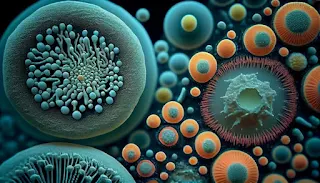Human Microbiology
Human Microbiology
Description also available in video
format (attached below), for better experience use your desktop
Introduction
·
Human microbiology is the study of microorganisms that reside within or
on the human body, collectively known as the human microbiota.
·
These microorganisms include bacteria, viruses, fungi, and other
single-celled organisms.
·
The human microbiota plays a crucial role in maintaining health and
influencing various physiological processes.
·
Here's an overview of some key aspects of human microbiology:
1. Microbiota
Composition
·
The human body hosts a diverse array of microorganisms, with the gut
microbiota being the most extensively studied.
·
Other significant sites include the skin, mouth, respiratory tract, and
reproductive organs.
·
Each of these sites has its unique microbial community, influenced by
factors such as diet, environment, genetics, and lifestyle.
2. Functions of the
Microbiota
·
The microbiota contributes to digestion, metabolism, immune function,
and protection against pathogens.
·
In the gut, for example, beneficial bacteria aid in the breakdown of
dietary fibers and the synthesis of essential vitamins like vitamin K and
certain B vitamins.
·
Additionally, the microbiota helps to educate and modulate the immune
system, influencing its development and response to pathogens.
3. Microbiome-Host
Interactions
·
The relationship between the human host and its microbiota is dynamic
and complex.
·
Microorganisms communicate with host cells through various mechanisms,
including chemical signaling and direct interaction with host receptors.
·
These interactions can have profound effects on host physiology and
health outcomes.
4. Dysbiosis and Disease
·
Imbalances or disruptions in the composition and function of the
microbiota, known as dysbiosis, have been linked to various health conditions,
including inflammatory bowel diseases, obesity, allergies, and even
neurological disorders like autism and depression.
·
Understanding the role of the microbiota in disease development and
progression is a major focus of research in human microbiology.
5. Therapeutic
Applications
·
Manipulating the microbiota holds promise as a therapeutic approach for
managing and preventing disease.
·
Strategies such as probiotics (live microorganisms with health
benefits), prebiotics (substances that promote the growth of beneficial
microorganisms), and fecal microbiota transplantation (transferring fecal
material from a healthy donor to a recipient) are being explored for their
potential in treating conditions associated with dysbiosis.
6. Technological
Advances
·
Recent advancements in DNA sequencing technologies have revolutionized
the field of human microbiology, enabling researchers to characterize the
microbiota with unprecedented detail.
·
Metagenomic sequencing techniques allow for the comprehensive analysis
of microbial communities, providing insights into their composition, diversity,
and functional capabilities.
Sterilization
·
Sterilization is a crucial concept in microbiology, referring to the
process of eliminating or destroying all forms of microbial life, including
bacteria, viruses, fungi, and spores. \
·
This process is essential in various fields such as healthcare,
pharmaceuticals, food industry, and research laboratories to prevent the spread
of infections, ensure product safety, and maintain sterile environments.
·
Here's an introduction to sterilization in terms of microbiology:
1. Purpose
·
The primary goal of sterilization is to achieve asepsis, which is the
absence of pathogenic microorganisms.
·
This ensures that surfaces, equipment, or substances are free from
contamination and safe for use.
2. Methods There are several
methods of sterilization, each with its advantages and limitations:
·
Heat Sterilization: This includes
techniques such as autoclaving (steam under pressure), dry heat sterilization,
and flaming. Heat denatures proteins and destroys microbial structures.
·
Chemical Sterilization: Chemical agents like
ethylene oxide, hydrogen peroxide, and glutaraldehyde are used to kill
microbes. These agents penetrate materials to reach hidden microorganisms.
·
Radiation Sterilization: Ionizing radiation
(gamma rays, X-rays) and non-ionizing radiation (ultraviolet light) are
employed to disrupt microbial DNA, rendering them unable to replicate.
·
Filtration: It involves passing substances through
a filter with fine pores that trap microorganisms, commonly used for
sterilizing heat-sensitive liquids and gases.
·
Gas Sterilization: Gaseous agents like
ethylene oxide penetrate materials to kill microorganisms, useful for
sterilizing heat- or moisture-sensitive items.
3. Validation
·
Sterilization processes must be validated to ensure effectiveness.
·
This involves verifying that the chosen method reliably eliminates or
reduces microbial populations to an acceptable level.
4. Sterility Assurance
·
Maintaining sterility involves proper handling, storage, and monitoring
of sterilized items to prevent recontamination.
·
Packaging materials must also be sterile to maintain sterility during
storage and transportation.
5. Applications: Sterilization is
used in various fields, including:
·
Healthcare: Sterilizing medical instruments,
surgical equipment, and implants to prevent infections during procedures.
·
Pharmaceutical Industry: Ensuring sterility
of drugs, vaccines, and biological products to maintain their efficacy and
safety.
·
Food Industry: Sterilizing food products and
packaging to prolong shelf life and prevent foodborne illnesses.
·
Laboratory Research: Sterilizing culture
media, glassware, and equipment to prevent cross-contamination and ensure
accurate experimental results.
6. Challenges: Achieving
sterilization can be challenging due to factors such as the resistance of
microbial spores, the presence of organic materials that can shield
microorganisms, and the need to balance effectiveness with the preservation of
delicate materials.
Anatomy of Bacteria
·
Bacteria are fascinating single-celled microorganisms that play crucial
roles in various ecosystems, including the human body.
·
Understanding their anatomy provides insights into their functions,
interactions, and potential vulnerabilities.
·
Here's an introduction to the anatomy of bacteria:
1. Cell Wall
·
Bacteria typically have a cell wall, which provides structural support
and protection.
·
The composition of the cell wall varies among different bacterial
species.
·
For example, some bacteria have a thick layer of peptidoglycan in their
cell wall, while others have a thinner layer or lack a cell wall altogether.
2. Cell Membrane (Plasma
Membrane)
·
Beneath the cell wall, bacteria have a cell membrane composed of lipids
and proteins.
·
This semi-permeable membrane regulates the passage of substances in and
out of the cell, allowing essential nutrients to enter and waste products to
exit.
3. Cytoplasm
·
The cytoplasm is the gel-like substance enclosed by the cell membrane.
·
It contains various structures, including the bacterial chromosome
(DNA), ribosomes (where protein synthesis occurs), and storage granules (for
storing nutrients such as glycogen or lipids).
4. Nucleoid
·
Unlike eukaryotic cells, bacteria do not have a true nucleus. Instead,
their DNA is usually found in a region of the cytoplasm called the nucleoid.
·
The bacterial chromosome is a single circular DNA molecule that contains
the genetic information necessary for the cell's functions and reproduction.
5. Ribosomes
·
Ribosomes are cellular structures responsible for protein synthesis.
·
In bacteria, ribosomes are smaller than those found in eukaryotic cells
and consist of two subunits.
·
They translate the genetic code from the bacterial chromosome into
functional proteins.
6. Flagella
·
Some bacteria possess flagella, which are long, whip-like structures
used for locomotion.
·
Flagella rotate to propel the bacterium through its environment,
allowing it to move towards nutrients or away from harmful substances.
7. Pili (Fimbriae)
·
Pili are hair-like appendages found on the surface of some bacteria.
·
They serve various functions, including attachment to surfaces or other
cells, facilitating genetic exchange through a process called conjugation, and
assisting in bacterial motility.
8. Capsule
·
Some bacteria produce a capsule, a protective layer outside the cell
wall.
·
The capsule helps bacteria evade the host immune system by preventing
phagocytosis (engulfment by immune cells) and provides protection against
desiccation and other environmental stresses.
9. Plasmids
·
Plasmids are small, circular DNA molecules separate from the bacterial
chromosome.
·
They often carry genes that provide advantages such as antibiotic
resistance or the ability to metabolize certain compounds.
·
Plasmids can be transferred between bacteria through conjugation.
10. Endospores
·
Certain bacteria have the ability to form endospores, which are highly
resistant structures that protect the bacterial chromosome in harsh conditions.
·
Endospores allow bacteria to survive extreme temperatures, desiccation,
and exposure to chemicals or radiation.
Bacteria
in Water and Milk
Bacteria can exist in both water and milk, and they can have significant
implications for human health if present in high concentrations or if they are
pathogenic (disease-causing). Here's a brief overview:
1. Water:
·
Pathogenic Bacteria
·
Water can harbor various pathogenic bacteria such as Escherichia coli
(E. coli), Salmonella, Vibrio cholerae, and Campylobacter jejuni, among others.
·
These bacteria can cause illnesses such as gastrointestinal infections,
cholera, and typhoid fever.
·
Non-Pathogenic Bacteria
·
Water also contains non-pathogenic bacteria, some of which are harmless
or even beneficial.
·
However, their presence in drinking water can indicate poor sanitation
or contamination, which may lead to health risks indirectly.
2. Milk:
·
Pathogenic Bacteria
·
Raw milk, in particular, can contain harmful bacteria such as
Escherichia coli O157:H7, Salmonella, Listeria monocytogenes, and
Campylobacter.
·
These bacteria can cause foodborne illnesses like diarrhea, vomiting,
fever, and in severe cases, life-threatening complications.
·
Spoilage Bacteria
·
Even if not pathogenic, spoilage bacteria like Pseudomonas,
Lactobacillus, and Enterobacter can proliferate in milk, leading to
off-flavors, souring, and curdling.
·
While not typically harmful, their presence indicates that the milk is
no longer fresh or suitable for consumption.
Culture Media and Methods
·
Culture media and methods are fundamental components of microbiology and
biotechnology, allowing researchers to cultivate and study microorganisms in
controlled environments.
Culture Media:
1. Classification based
on Physical State:
·
Liquid Media: Usually used for growing organisms in
suspension. Examples include broth or nutrient broths.
·
Solid Media: These contain gelling agents like agar
to solidify the medium. Used for isolating and enumerating microorganisms.
Examples include agar plates and agar slants.
2. Classification based
on Nutrient Content:
·
Chemically Defined Media: Exact chemical
composition is known. Useful for studying specific metabolic pathways.
·
Complex Media: Contain extracts from natural sources
(e.g., yeast extract, beef extract). Used when the exact nutritional
requirements of microorganisms are not known.
3. Specialized Media:
·
Selective Media: Designed to favor the growth of
specific microorganisms while inhibiting others.
·
Differential Media: Allow for the
differentiation of organisms based on their metabolic characteristics.
·
Enrichment Media: Encourage the growth of specific
microorganisms by providing specific growth factors.
Methods:
1. Sterilization: Ensures the
elimination of all microorganisms from the media and equipment to prevent
contamination. Common methods include autoclaving, filtration, and irradiation.
2. Inoculation: Introduction of a
sample into a medium for culture. Techniques include streaking, spreading, and
pouring.
3. Incubation: Maintaining cultures
at a specific temperature and environmental conditions favorable for growth.
Incubators provide controlled temperature, humidity, and sometimes CO2 levels.
4. Identification: Various techniques
are used to identify microorganisms, including microscopy, biochemical tests,
molecular methods like PCR, and mass spectrometry.
5. Subculturing: Transferring a small
amount of culture to a fresh medium to sustain growth or for further
experimentation.
6. Preservation: Methods like
freezing (at -80°C), lyophilization (freeze-drying), and storage in glycerol or
other cryoprotectants are used to preserve cultures for long-term storage.
Applications:
·
Medical Microbiology: Diagnosis of
infectious diseases, antibiotic susceptibility testing.
·
Industrial Microbiology: Production of
antibiotics, enzymes, vaccines, and other biotechnological products.
·
Environmental Microbiology: Studying microbial
communities in various ecosystems, bioremediation.
·
Food Microbiology: Ensuring food
safety, fermentation processes.
Video Description
· Don’t forget to do these things if
you get benefitted from this article
o Visit our Let’s contribute
page https://keedainformation.blogspot.com/p/lets-contribute.html
o Follow our page
o Like & comment on our post
·


.jpeg)
.jpeg)



Comments